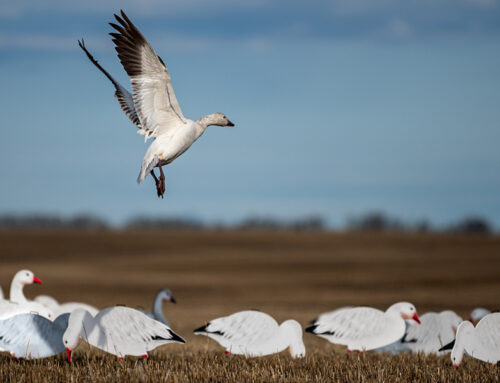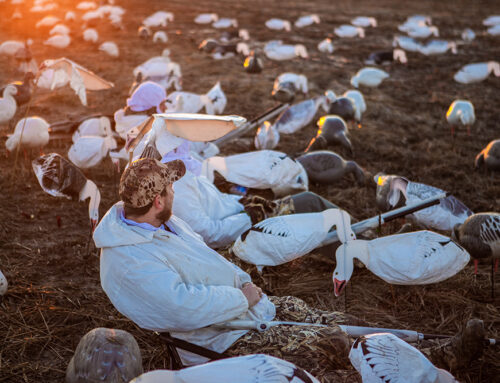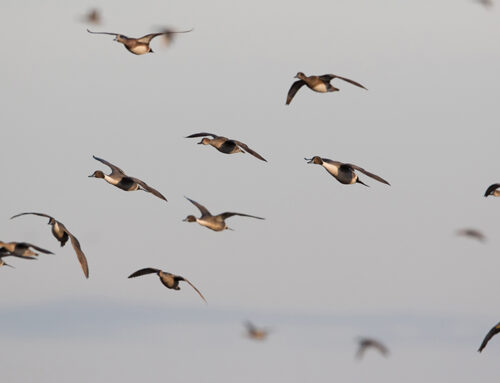Get the Range Right

By Bill Miller
Advances in shotshell technology make it possible for us to effectively and efficiently take ducks and geese at greater ranges than our predecessors ever dreamed. Today’s shot materials, modern powders, wad designs and hull refinements combine to outshine antique soft lead and waxed cardboard technology in every way.
Utilizing the extended range of today’s non-toxic loads comes down to hunters’ shooting skills — a major part of which is the ability to judge the distance to ducks and geese. Whether it’s ethical to shoot birds at a given range is truly based on the individual hunter’s dedication to skills improvement.
I don’t advocate for long-range shooting. Personally, I’m into waterfowl hunting for the hunting. For me, the measure of success is in doing everything right to fool the birds so completely they’ll nearly land on the toes of my waders. If they come so close I could touch their feathers … that is a greater measure of success than a limit.
But I like to bag ducks, too. The dog, especially, becomes bored if I don’t. So I shoot most of my birds, like everyone else, beyond grabbing distance. However, whether you like the challenge of bringing birds inside 25 yards or the shooting challenge of taking them “way out there,” range estimation is a critical skill.
Technology helps, too. These days a rangefinder is ever-present in my blind bag. It comes into play in setting up, hunting, scouting and more.
When you’re setting up to hunt, a rangefinder assists in determining distances from the blind to specific, easily remembered objects. Then when birds are approaching, you can use these landmarks to determine range. How distant is the far edge of the pond? How far is that Delta Hen House or wood duck box? What’s the range to that clump of cattails?
Also use the rangefinder when you’re setting decoys. Range back to the blind from the most distant decoy in the string, and note the distance. I also set distinct confidence decoys like egrets or blue herons at the edge of max shooting range. And on a big-water string, a magnum canvasback in a string of bluebills stands out. They’re easy to see and remember, and I know I can shoot once the ducks are inside the egrets or the can decoy. Just don’t make it too complicated — you’ll second-guess yourself, and the greatest detriment to good shooting is thinking too much.
Hunting with partners, take turns behind the rangefinder calling out distances as birds approach. Lock on a bird in the flock and call out 20-yard increments, for example, “200, 180 … 100, 80, 60, 40, TAKE ’EM!” If all the hunters in your crew cooperate, you’ll be amazed at how much everyone’s shooting improves! You’ll also each hone your instinctive range estimation skills by expanding your mental file of how birds look at different ranges.
For this purpose, select a rangefinder built on golfing technology that locks the laser on small targets. On the golf course, it’s the flagstick — in the field, it’s a specklebelly moving through the sky. Also use a rangefinder with scanning mode. In this mode, the read out will automatically update as the “target” range changes without pushing the readout button again and again.
Take along your rangefinder whenever you’re just out looking at birds, too. It’s great practice. Estimate the range, then bring the optics to bear. The speed at which your skills improve will amaze you.
Traditionally, we’ve been taught to estimate range by the detail we can see on birds. The old ammo posters told us if we could see the chinstrap on a honker, that was 70 yards, and if you could see its eye, it was 40 yards. Problem is, weather, lighting, angles, and individuals’ eyesight acuity are too variable. By making your estimate, then verifying with the optics, you’re creating a mental database of what a mallard looks like to you at 40 yards and what a giant Canada goose looks like to you at 70 yards.
The other bad advice on those posters was to gauge the width of your gun barrel in comparison to flying birds to determine range. First, it meant you had to mount your gun, which would likely flare birds. If you mounted too soon, then you’ve alerted the bird(s) beyond range. Secondly, one of the surest ways to miss in wingshooting is shifting focus back and forth between your barrel and your target. For high percentage shooting, you focus on your target and forget the barrel/bead is even there.
Bonus tip: Not so obviously, a rangefinder is a valuable scouting tool. The best strategy in waterfowl hunting is to put yourself exactly where the birds want to be. That means scouting, marking the precise location birds are using, and refinding the spot in the dark. The combination of rangefinder and GPS makes it easy.
Find a flock in a field you can hunt. Stop at a distance that won’t spook the birds. Punch in a GPS waypoint. Range the center of the flock in the field, and note the exact compass bearing on which you’re ranging. As soon as you’re out of sight of the birds, put a marker into the GPS that locates the distance to the birds on the same bearing. You’ve just located the center of your spread for the next morning. Find more flocks and mark backup fields. Next morning, you have an exact spot you can pinpoint even in thick fog. And if someone arrives ahead of you, move on to Plans B, C or D.
Another reason for a rangefinder in your blind bag is to determine how close is too close — not to birds, but to other hunters. On popular public hunting areas, multiple sets in a small area are the way it goes. The closest I like to set to anyone else is 300 yards. Equally, I hate it when another spread encroaches closer to mine. Too many guys don’t know what 300 yards looks like. With a rangefinder, you can prove to folks that they’re too close.





Leave A Comment